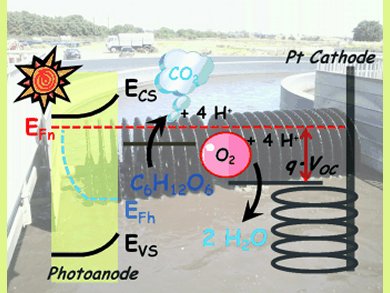A solar-energy-driven biomass fuel cell for the production of electricity from wastewater using only air and light as additional resources is described by Rachel L. Chamousis and Frank E. Osterloh, University of California, Davis, USA. The device consists of a photoelectrochemical cell that contains a nanostructured titanium dioxide or tungsten trioxide film as photoanode and a platinum air electrode as cathode, in separate compartments.
Devices were tested with electrolyte only, synthetic wastewater, or with aqueous glucose solution, under irradiation with sunlight, broad spectral illumination, and monochromatic light.
The power depends strongly on the electrode material and illumination and can reach up to 0.73 mWcm–2, equivalent to three times the performance of microbial fuel cells. Measured light conversion efficiencies were between 0.007 % and 1.7 %, depending on conditions. The highest efficiency (1.7 %) and power output (0.73 mWcm–2) are determined for TiO2 electrodes under 395 nm illumination. In contrast to TiO2, the WO3 electrodes are active under visible light (>440 nm), but the IPCE value is low (2 %).
The performance of the cells remains significantly below the Shockley–Queisser limit. This is in part due to the low fill factors, which result from sub-optimal device geometry leading to high transport resistance.
- A Light-Assisted Biomass Fuel Cell for Renewable Electricity Generation from Wastewater,
Rachel L. Chamousis, Frank E. Osterloh,
ChemSusChem 2012.
DOI: 10.1002/cssc.201200016




